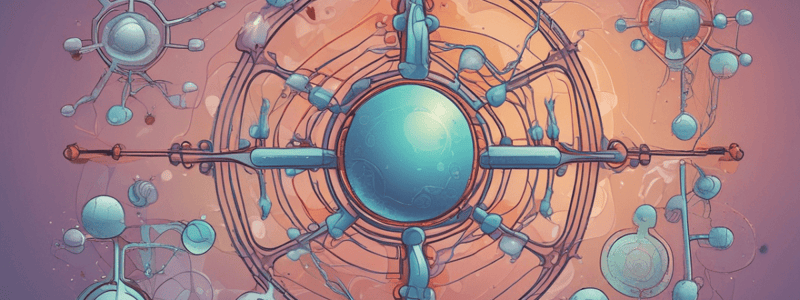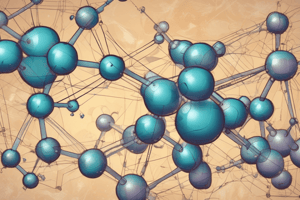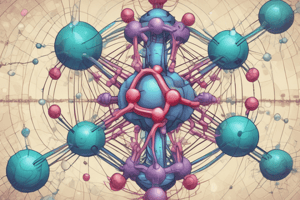Podcast
Questions and Answers
What is the final product of the reaction involving 1-butene?
What is the final product of the reaction involving 1-butene?
- 1° alkyl (correct)
- Terminal alkene
- Internal alkene
- 2° alkyl
Why is the 1° alkyl thermodynamically more stable than the 2° alkyl?
Why is the 1° alkyl thermodynamically more stable than the 2° alkyl?
- Electronic reasons
- Steric reasons (correct)
- Kinetic reasons
- Solubility reasons
What can be done with the 1° alkyl after its formation?
What can be done with the 1° alkyl after its formation?
- It can only be converted to a 2° alkyl
- It cannot be functionalized
- It can only be converted to a terminal alkene
- It can be functionalized in a number of ways (correct)
What is the preferred position of the metal in the LnM–H insertion product for ArCH=CH2?
What is the preferred position of the metal in the LnM–H insertion product for ArCH=CH2?
Why does the equilibration of the two regioisomers favor the thermodynamic product?
Why does the equilibration of the two regioisomers favor the thermodynamic product?
Why is the new C–H′ bond in 7.8 stronger than in 7.7?
Why is the new C–H′ bond in 7.8 stronger than in 7.7?
What is the result of 1e oxidation of Cp(CO)2FeIIMe at −78°C in MeCN?
What is the result of 1e oxidation of Cp(CO)2FeIIMe at −78°C in MeCN?
Why is the migration of Me− to the CO carbon expected to be faster in the 17e, Fe(III) acyl complex?
Why is the migration of Me− to the CO carbon expected to be faster in the 17e, Fe(III) acyl complex?
What type of ligands do early d0 metals prefer?
What type of ligands do early d0 metals prefer?
What is the role of the solvent in the oxidation of Cp(CO)2FeIIMe?
What is the role of the solvent in the oxidation of Cp(CO)2FeIIMe?
What is the effect of the limited back bonding in d0 Zr(IV) and Th(IV) complexes?
What is the effect of the limited back bonding in d0 Zr(IV) and Th(IV) complexes?
What is the outcome of the reaction shown in Eq. 7.17?
What is the outcome of the reaction shown in Eq. 7.17?
What is the unique property of SO2 as a ligand?
What is the unique property of SO2 as a ligand?
What is the typical direction of insertion reactions involving SO2?
What is the typical direction of insertion reactions involving SO2?
What is the requirement for the cis arrangement of ligands in insertion reactions?
What is the requirement for the cis arrangement of ligands in insertion reactions?
What is the effect of binding an external 2e ligand on the insertion product?
What is the effect of binding an external 2e ligand on the insertion product?
What is the requirement for the elimination reaction to occur?
What is the requirement for the elimination reaction to occur?
What is the change in formal oxidation state of the metal during the insertion reaction?
What is the change in formal oxidation state of the metal during the insertion reaction?
What is the role of the nucleophilic hydride in the reaction involving CO2?
What is the role of the nucleophilic hydride in the reaction involving CO2?
What is the difference between the kinetic and thermodynamic products of the reaction involving SO2?
What is the difference between the kinetic and thermodynamic products of the reaction involving SO2?
Why does the reactivity of the reaction involving SO2 fall off for bulky alkyls and electron-attracting substituents?
Why does the reactivity of the reaction involving SO2 fall off for bulky alkyls and electron-attracting substituents?
What is the significance of the crossover reaction of a mixture of RS and SR isomers of [CpFe*(CO)L{CH2C*H(Me)Ph}]?
What is the significance of the crossover reaction of a mixture of RS and SR isomers of [CpFe*(CO)L{CH2C*H(Me)Ph}]?
What is the reason for the formation of an alkyl sulfinate ion when SO2 electrophilically attacks the α carbon of an 18e alkyl?
What is the reason for the formation of an alkyl sulfinate ion when SO2 electrophilically attacks the α carbon of an 18e alkyl?
What is the type of insertion that occurs when SO2 reacts with an 18e alkyl?
What is the type of insertion that occurs when SO2 reacts with an 18e alkyl?
What is the likely reason why 7.8 is preferred as a product?
What is the likely reason why 7.8 is preferred as a product?
What is the outcome of insertion in simple α-olefins?
What is the outcome of insertion in simple α-olefins?
What happens to the cis-vinyl complex during syn insertion?
What happens to the cis-vinyl complex during syn insertion?
Why is the radical formed in 7.8 more stable?
Why is the radical formed in 7.8 more stable?
What is the general principle for interpreting reactivity trends?
What is the general principle for interpreting reactivity trends?
What type of substituents may exhibit similar trends to –Ar?
What type of substituents may exhibit similar trends to –Ar?
Flashcards are hidden until you start studying



